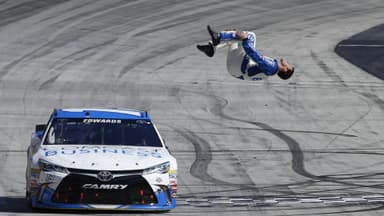The Next Gen NASCAR Cup car might not be everyone’s favorite but it certainly is a complex piece of machinery. One of the parts of the car that people close to the sport keep talking about is the spoiler.
Advertisement
A spoiler is a clear polycarbonate piece almost like a rear wing for the car and it plays a huge role in making the machines go faster or slower, along with making them race-able for the drivers.
Today, the NASCAR Cup Series uses two types of spoilers — one for superspeedway tracks and one for every other track. Both essentially have the same purpose, but with altered levels of downforce and subsequently drag, which helps in limiting the machines’ top speeds depending upon the venue they are visiting.
The Next Gen car relies both on its wing as well as its underbody downforce generated by the diffuser to create downforce. This phenomenon is called ground effects and is one of the most intriguing pieces of motorsports technicality.
With stock car racing primarily focussed on oval tracks, the governing body curbs the cars’ top speeds by using a seven-inch tall spoiler at superspeedways, a style of track often known for its spectacular crashes and high speeds.
NASCAR released a new aero package for short tracks and road courses. Let's do a thread on what that looks like and what it means.
This new package will see changes to:
-spoiler
-diffuser strakes
-diffuser skirts
-engine panel strakesThis is where those pieces are located: pic.twitter.com/TmSsOIWZZQ
— Bozi Tatarevic (@BoziTatarevic) March 1, 2023
The other kind of spoiler is four inches tall and is used at every other race track. Due to its short height, only a small fraction of the air hits its surface. While this massively reduces drag, it also reduces downforce and rear-tire grip.
It tests a driver’s race craft on certain intermediate tracks as a result and costs $79 per piece. Shane Van Gisbergen gave further perspective on the topic as he explained one of the biggest differences between an Australian V8 Supercar and a Next Gen NASCAR Cup car through the means of this very aerodynamic device, which essentially has the same function and principle behind it.
The V8 Supercars platform generates a lot more grip from the rear tires with the help of a wing, which in simplified terms is a spoiler, only bigger.
One of the biggest positives of the Next Gen is how it runs on intermediate tracks, further solidifying how well the package works at 1.5-mile-long venues in the modern-day.
However, as it has been discussed widely ever since the introduction of the seventh-generation racecar, there are still ways to go in improving the short track and superspeedway package when it comes to the quality of racing.





